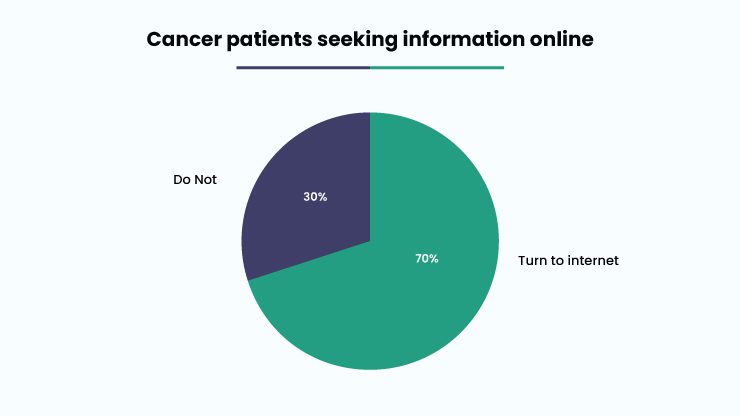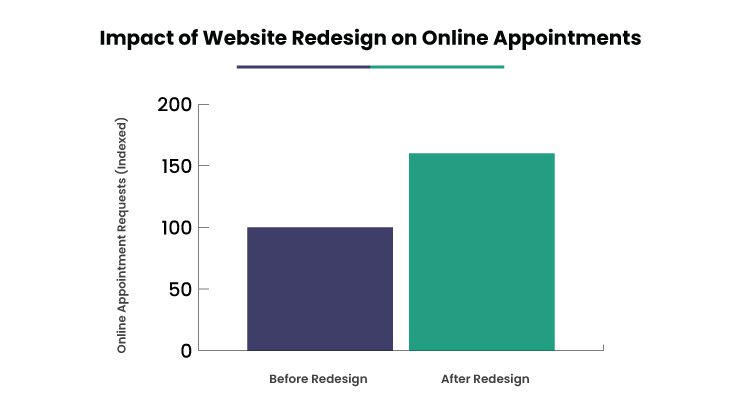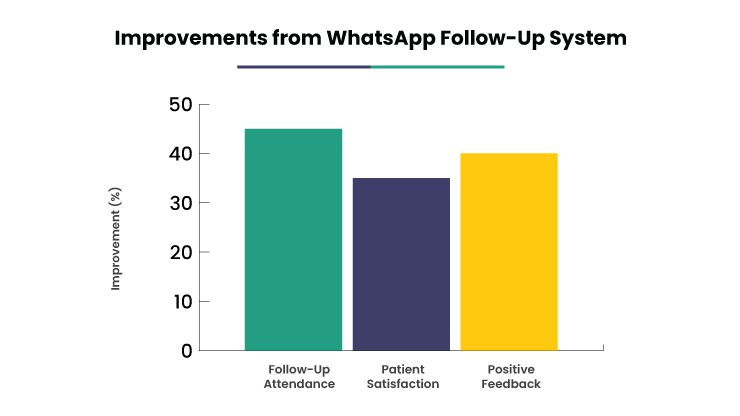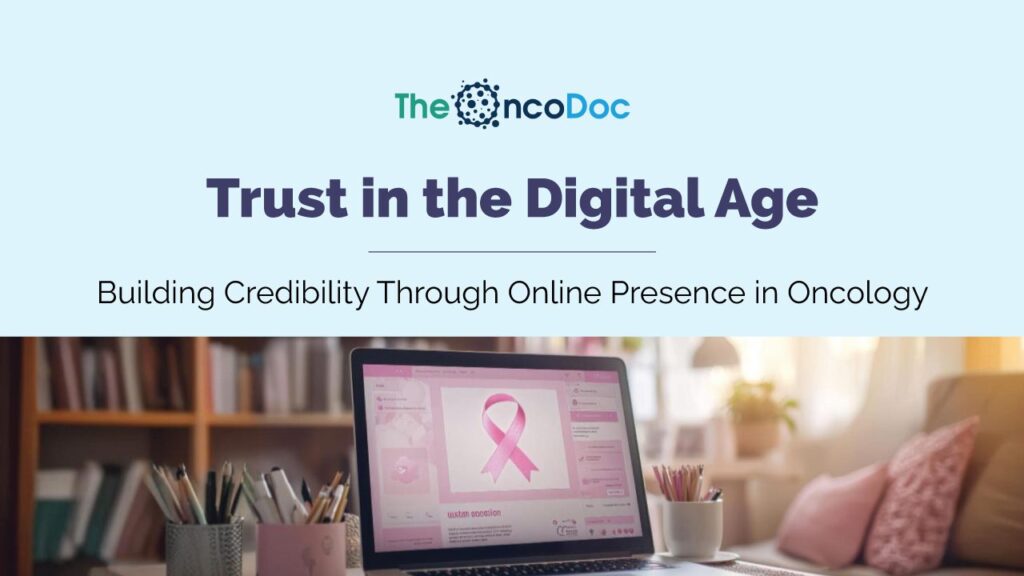Introduction
In the modern healthcare landscape, the journey of a cancer patient often begins not in a hospital, but through a simple online search. The internet has evolved into a vital space for information, emotional support, and guidance, especially for individuals navigating the complexities of cancer diagnosis and treatment.
As the healthcare sector increasingly embraces digital transformation, oncologists are expected not only to provide expert clinical care but also to establish a credible and compassionate online identity. This shift demands an ethical, patient-centric approach to digital engagement- one that fosters trust and reassures patients long before they walk into a consultation room.
“A patient’s first interaction with cancer care often occurs through a screen. The digital space is where trust begins to take root.”
– Dr. Meera Bhatia, Consultant Oncologist

Why Digital Engagement Matters in Oncology
Surveys suggest that over 70% of individuals newly diagnosed with cancer turn to the internet to learn more about their symptoms, treatment options, and care providers. In oncology, where fear and uncertainty are common, digital interactions play a significant role in shaping patient decisions and perceptions.
Digital platforms are essential for:
- Establishing trust by offering clear, transparent, and professional information
- Correcting misinformation through evidence-based resources
- Providing emotional comfort through stories, testimonials, and supportive communication
For many, accessing trustworthy information online can reduce anxiety and prepare them better for their medical journey.
Building a Patient-Centered Digital Strategy
1. Creating a Reassuring Online Presence
A clinic’s website often forms a patient’s first impression. It must be warm, easy to navigate, and informative. The tone should be supportive, the language simple, and the visuals reflective of real people and real care.
Essential features of an effective oncology website:
- Welcoming messages and introductions from doctors
- Easy-to-understand descriptions of treatment procedures
- Informative videos that explain tests or therapies
- A section addressing frequently asked patient concerns
- User-friendly options for scheduling appointments or requesting second opinions
Case Example: A Hyderabad cancer clinic redesigned its website to include videos, doctor bios, and patient testimonials, which led to a 60% rise in online appointment requests.

2. Using Education to Empower
Cancer-related terms like “biopsy,” “metastasis,” or “targeted therapy” can sound intimidating to patients. Creating educational content helps demystify these concepts and promotes shared decision-making.
Helpful formats for patient education:
- Blog articles breaking down medical terms
- Short animated videos to explain complex procedures
- Interactive infographics showcasing the treatment journey
- Downloadable guides tailored for caregivers or newly diagnosed patients
The goal is to make information digestible without compromising on accuracy
3. Connecting Through Social Media
Social platforms like Instagram, Facebook, and YouTube offer powerful avenues for humanizing cancer care. These platforms allow oncologists and hospitals to share insights, success stories, and awareness messages with a wide audience.
Effective content ideas include:
- Weekly myth-busting posts on common misconceptions
- Stories shared by cancer survivors and caregivers
- Awareness campaigns tied to international health observances
- Live Q&A sessions hosted by doctors
Real-life Insight: A Pune-based oncologist’s series on “Everyday Cancer Questions” drew widespread engagement by answering patient queries in a conversational style.
4. Keeping Patients Informed Post-Consultation
A single consultation may not answer all of a patient’s questions. Timely digital communication helps extend support and keeps patients connected with their care team.
Examples of meaningful outreach:
- Email newsletters highlighting new treatments or wellness tips
- WhatsApp updates about upcoming check-ups or support groups
- Text message reminders for medication or follow-up visits.
Best practice: Always give patients the option to opt-in and control the frequency of messages.
Prioritizing Ethics and Privacy in Oncology Communication
Because oncology involves sensitive health information, all digital communication must be handled with confidentiality and respect.
Avoid the following practices:
- Promising specific treatment outcomes
- Sharing patient stories or photos without full consent
- Using distressing imagery or fear-based messaging
- Tracking or targeting users based on presumed health conditions
What to follow instead:
- Adhere to regional and international privacy laws such as HIPAA or GDPR
- Include clear disclaimers for all informational content
- Make privacy policies easily accessible on all digital platforms
- Encrypt data and avoid collecting unnecessary personal information
“Respecting privacy is not just about compliance- it’s about earning and maintaining trust.”
– Dr. Anish Gupta, Data Security Advisor in Healthcare
Humanizing Technology in Cancer Care
As digital tools evolve, it’s crucial to balance automation with empathy.
Automated chatbots can offer round-the-clock support for common patient queries. These systems help clarify basic doubts, provide links to relevant content, and escalate more complex issues to human staff when necessary.
Telemedicine has made cancer care more accessible, particularly for follow-ups and second opinions. It benefits patients in remote areas and those unable to travel frequently due to fatigue or financial constraints.
Moderated online communities help connect patients with survivors or psychologists. These spaces allow sharing of experiences, advice, and encouragement- fostering a sense of belonging.
Illustration: A support group hosted by a Kochi-based cancer center on Telegram helped reduce patient dropout rates during chemotherapy by 30% over one year.
Real-World Example: Personalized Outreach That Resonates
A cancer care unit in Indore introduced a WhatsApp follow-up system that included post-discharge support, motivational messages, and nutritional tips. This small digital step had a significant impact:
- 45% improvement in follow-up attendance
- Higher patient satisfaction ratings
- Increased positive feedback on care continuity
“Digital engagement isn’t just about efficiency- it’s about reminding patients they are not alone.”
-Dr. Reema Kulkarni, Director, Horizon Oncology Centre

Training Oncologists to Embrace the Digital Shift
Many oncologists are understandably cautious about engaging online due to concerns around professionalism or misinterpretation. Institutions can help bridge this gap through tailored training programs.
Recommended training modules:
- Basics of social media etiquette and ethical posting
- Creating content in collaboration with communication teams
- Understanding SEO and online visibility
- Managing professional boundaries in digital spaces
Workshops, online courses, or even short mentorship programs can significantly improve confidence among clinicians.
Future-Proofing Oncology’s Digital Presence
To remain relevant and effective, digital oncology strategies must evolve.
Voice Search Optimization
Patients increasingly use voice assistants to seek medical information. Ensuring websites are voice-search friendly improves accessibility.
Regional and Multilingual Content
Providing health information in regional languages ensures inclusivity, particularly in multilingual countries. It helps break literacy and language barriers in cancer care communication.
Customized Patient Journeys
With informed consent, digital tools can be used to send targeted messages based on the patient’s treatment phase. For instance:
- Motivational messages during chemotherapy
- Nutritional tips during recovery
- Reminders for screening and check-ups
These thoughtful touches enhance the continuity and quality of care.
In cancer care, where decisions carry life-changing implications, trust is non-negotiable. The digital space, when used with empathy and ethics, becomes a powerful tool for informing, supporting, and uplifting patients.
By investing in a compassionate digital presence, oncologists can do more than share medical facts, they can offer reassurance, build connections, and become a guiding light in a patient’s most vulnerable moments.
Because today, care doesn’t only happen inside hospitals- it begins with a search bar, a click, or a message that says, “We’re here for you.”
The Oncodoc team is a group of passionate healthcare and marketing professionals dedicated to delivering accurate, engaging, and impactful content. With expertise across medical research, digital strategy, and clinical communication, the team focuses on empowering healthcare professionals and patients alike. Through evidence-based insights and innovative storytelling, Hidoc aims to bridge the gap between medicine and digital engagement, promoting wellness and informed decision-making.



